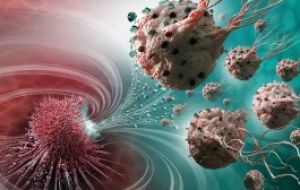MercoPress. South Atlantic News Agency
Nanorobotic agents in the bloodstream to combat active cancerous cells of tumors
 The article “Magneto-Aerotactic Bacteria Deliver Drug-Containing Nanoliposomes To Tumor Hypoxic Regions”, was published in Nature Nanotechnology
The article “Magneto-Aerotactic Bacteria Deliver Drug-Containing Nanoliposomes To Tumor Hypoxic Regions”, was published in Nature Nanotechnology  The article notes the results of the research done on mice, which were successfully administered nanorobotic agents into colorectal tumors.
The article notes the results of the research done on mice, which were successfully administered nanorobotic agents into colorectal tumors.  “The drug’s propelling force was enough to travel efficiently and enter deep inside the tumors” said Prof Sylvain Martel, from the Polytechnique Nanorobotics Lab.
“The drug’s propelling force was enough to travel efficiently and enter deep inside the tumors” said Prof Sylvain Martel, from the Polytechnique Nanorobotics Lab. Researchers from Polytechnique Montréal, Université de Montréal and McGill University have just achieved a spectacular breakthrough in cancer research. They have developed new nanorobotic agents capable of navigating through the bloodstream to administer a drug with precision by specifically targeting the active cancerous cells of tumors.
This way of injecting medication ensures the optimal targeting of a tumor and avoids jeopardizing the integrity of organs and surrounding healthy tissues. As a result, the drug dosage that is highly toxic for the human organism could be significantly reduced.
This scientific breakthrough has just been published in the journal Nature Nanotechnology in an article titled “Magneto-Aerotactic Bacteria Deliver Drug-Containing Nanoliposomes To Tumor Hypoxic Regions.”
The article notes the results of the research done on mice, which were successfully administered nanorobotic agents into colorectal tumors.
“These legions of nanorobotic agents were actually composed of more than 100 million flagellated bacteria – and therefore self-propelled – and loaded with drugs that moved by taking the most direct path between the drug’s injection point and the area of the body to cure,” explains Professor Sylvain Martel, holder of the Canada research chair in medical nanorobotics and director of the Polytechnique Montréal Nanorobotics Laboratory, who heads the research team’s work.
“The drug’s propelling force was enough to travel efficiently and enter deep inside the tumors.”
When they enter a tumor, the nanorobotic agents can detect in a wholly autonomous fashion the oxygen-depleted tumor areas, known as hypoxic zones, and deliver the drug to them. This hypoxic zone is created by the substantial consumption of oxygen by rapidly proliferative tumor cells. Hypoxic zones are known to be resistant to most therapies, including radiotherapy.




Top Comments
Disclaimer & comment rules-

-

Read all commentsIn the old days we had pretty gitls on such stories...
Sep 07th, 2016 - 08:17 am 0https://m.youtube.com/watch?v=VcMwNSiQ8Jk
Well,
Sep 07th, 2016 - 01:05 pm 0the TV this morning was talking about intimate relations with robots ??
What is this world coming to ..
Commenting for this story is now closed.
If you have a Facebook account, become a fan and comment on our Facebook Page!